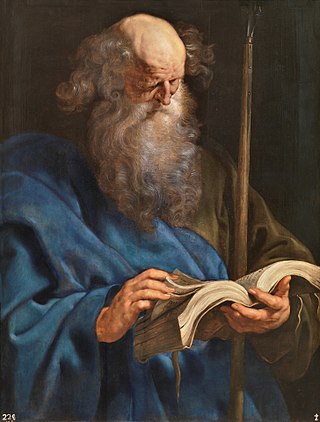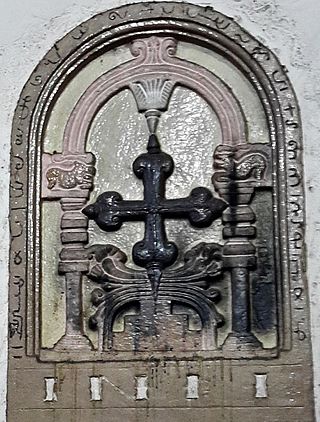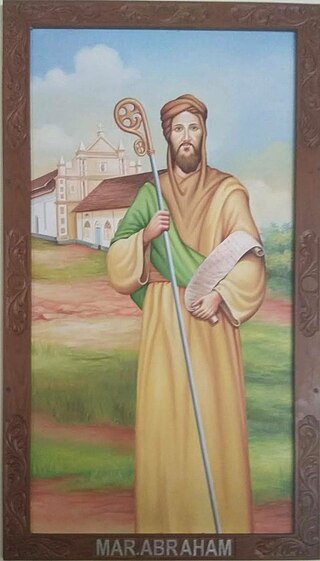
Thomas the Apostle, also known as Didymus, was one of the Twelve Apostles of Jesus according to the New Testament. Thomas is commonly known as "Doubting Thomas" because he initially doubted the resurrection of Jesus Christ when he was told of it ; he later confessed his faith on seeing the wounds left over from the crucifixion.

The Saint Thomas Christians, also called Syrian Christians of India, Marthoma Suriyani Nasrani, Malankara Nasrani, or Nasrani Mappila, are an ethno-religious community of Indian Christians in the state of Kerala, who, for the most part, employ the Eastern and Western liturgical rites of Syriac Christianity. They trace their origins to the evangelistic activity of Thomas the Apostle in the 1st century. The Saint Thomas Christians had been historically a part of the hierarchy of the Church of the East but are now divided into several different Eastern Catholic, Oriental Orthodox, Protestant, and independent bodies, each with their own liturgies and traditions. They are Malayalis and speak Malayalam. Nasrani or Nazarene is a Syriac term for Christians, who were among the first converts to Christianity in the Near East.

The Syro-Malabar Catholic Church is an Eastern Catholic church based in Kerala, India. The Syro-Malabar Church is an autonomous particular church in full communion with the pope and the worldwide Catholic Church, including the Latin Church and the 22 other Eastern Catholic churches, with self-governance under the Code of Canons of the Eastern Churches (CCEO). The Church is headed by the Major Archbishop of the Syro-Malabar, currently George Alencherry. The Syro-Malabar Synod of Bishops canonically convoked and presided over by the Major Archbishop constitutes the supreme authority of the Church. The Major Archiepiscopal Curia of the Church is based in Kakkanad, Kochi. Syro-Malabar is a prefix reflecting the church's use of the East Syriac Rite liturgy and origins in Malabar. The name has been in usage in official Vatican documents since the nineteenth century.

Christianity is India's third-largest religion with about 27.8 million adherents, making up 2.3 percent of the population as of the 2011 census. The written records of the Saint Thomas Christians state that Christianity was introduced to the Indian subcontinent by Thomas the Apostle, who sailed to the Malabar region in the present-day Kerala state in 52 AD.

The Chaldean Syrian Church of India is an Eastern Christian denomination, based in Thrissur, in India. It is organized as a metropolitan province of the Assyrian Church of the East, and represents traditional Christian communities of the East Syriac Rite along the Malabar Coast of India. It is headed by Mar Aprem Mooken, Metropolitan of India, who is in full communion with Patriarch Mar Awa III, head of the Assyrian Church of the East. Metropolitan is assisted by two Bishops, Mar Yohannan Yoseph, and Mar Awgin Kuriakose.

Joseph Vaz was an Oratorian priest and missionary in Sri Lanka (Ceylon), originally from Sancoale in Portuguese India.

The Catholic Church in India is part of the worldwide Catholic Church under the leadership of the Pope. There are over 20 million Catholics in India, representing around 1.55% of the total population, and the Catholic Church is the single largest Christian church in India. There are 10,701 parishes that make up 174 dioceses and eparchies, which are organised into 29 ecclesiastical provinces. Of these, 132 dioceses are of the Latin Church, 31 of the Syro-Malabar Catholic Church & 11 of the Syro-Malankara Catholic Church. Despite the very small population that Indian Catholics make up percentage wise, India still has the second-largest Christian population in Asia after the Catholic Church in the Philippines.

This article lists the various old and ancient churches that exist among the Saint Thomas Christians in Kerala.

The Jacobite Syrian Christian Church (JSCC), or the Malankara Archdiocese of the Syrian Orthodox Church in India also known as Malankara Jacobite Syrian Orthodox Church, the Jacobite Syrian Church, and the Syriac Orthodox Church in India, is a catholicate based in Kerala, India, of the Syriac Orthodox Church of Antioch and part of the Oriental Orthodox Church. It recognizes the Syriac Orthodox Patriarch of Antioch and All the East as supreme head of the church. It functions autonomously within the church, administered by the Metropolitan Trustee, under the authority of the Maphrian of India, Baselios Thomas I. Following schism with the Malankara Orthodox Syrian Church, is currently the only church in Malankara that is directly under a Syriac Christian Antiochian hierarchy, claiming continuity to the 1665 schism. The church employs the West Syriac Rite Liturgy of Saint James.

Saint Thomas Christian crosses are ancient crosses associated with the community of Indian subcontinent, who trace their origins to the evangelism of Thomas the Apostle in the 1st century AD. The Saint Thomas Christians, which is one of the oldest Christian communities of the world, survive in the Malabar region in state of Kerala, India and have a diaspora in other parts of the Indian subcontinent. Saint Thomas Christian crosses are known as Mar Thoma Sleeva, Indian cross, or Persian Cross in English, as well as Nasrani Sthambam in Malabarese.
Aghanashini / Agaçaim or Agassaim, is a village on the northern banks of the Zuari River in Tiswadi, Goa, surrounded by Panjim to the north, Margão to the south, Vasco da Gama to the west and Ponda to the east, thus making it a main connection between North Goa and South Goa via the Zuari Bridge. Agaçaim is famous for its Goan chouriço.

Mar Sabor and Mar Proth, according to Syrian Malabar Christian tradition, were two Chaldean Assyrian bishops who landed in the port of Kollam by the help of a Nestorian merchant, Sabr Iso in 823 AD. The mission is said to have received permission from the then king of Kerala to build a church in Kollam.

The indigenous population of the erstwhile Portuguese colony of Goa, Daman and Diu underwent Christianisation following the Portuguese conquest of Goa in 1510. The converts in the Velhas Conquistas to Roman Catholicism were then granted full Portuguese citizenship. Almost all present-day Goan Catholics are descendants of these native converts, they constitute the largest Indian Christian community of Goa state and account for 25 percent of the population.

Palliveettil Chandy also known as Parambil Chandy was a bishop of the Catholic Saint Thomas Christians. He is also the first known native Indian bishop. He was the bishop of the East Syriac Rite (Chaldaean) faction after the Coonan Cross Oath in 1653. This faction returned to full communion with the Holy See of Rome, it would later become known as the modern-day Eastern Catholic Syro-Malabar Church. Mar Chandy's tomb is at the Marth Mariam Major Archiepiscopal Church at Kuravilangad.

Metropolitanate of India was an East Syriac ecclesiastical province of the Church of the East, at least nominally, from the seventh to the sixteenth century. The Malabar region (Kerala) of India had long been home to a thriving Eastern Christian community, known as the Saint Thomas Christians. The community traces its origins to the evangelical activity of Thomas the Apostle in the 1st century. The Christian communities in India used the East Syriac Rite, the traditional liturgical rite of the Church of the East. They also adopted some aspects of Dyophysitism of Theodore of Mopsuestia, often inaccurately referred as Nestorianism, in accordance with theology of the Church of the East. It is unclear when the relation between Saint Thomas Christian and the Church of the East was established. Initially, they belonged to the metropolitan province of Fars, but were detached from that province in the 7th century, and again in the 8th, and given their own metropolitan bishop.

Champakulam Kalloorkadu St. Mary's Basilica is an ancient Christian Church in Kerala. It belongs to the Syro-Malabar Church under the Archeparchy of Changanacherry. It is a Forane church, with several parishes under it.

The Saint Thomas Christian denominations are Christian denominations from Kerala, India, which traditionally trace their ultimate origins to the evangelistic activity of Thomas the Apostle in the 1st century. They are also known as "Nasranis" as well. The Syriac term "Nasrani" is still used by St. Thomas Christians in Kerala.
Hubert Olympus Mascarenhas, born in Porvorim, Goa, in 1905, died at Mumbai, on 9 February 1973, was a Catholic priest belonging to the Archdiocese of Bombay, indologist of repute, and nationalist.

Abraham of Angamaly was the last East Syrian bishop of the See of Angamaly, who entered into communion with Rome in 1565 and who was the last link in Angamaly from the long line of the bishops from the East Syriac bishops sent from the Church of the East to the Saint Thomas Christians. He first came to India in 1556 from the traditionalist patriarchate. Deposed from his position in 1558, he was taken to Lisbon by the Portuguese, escaped at Mozambique and left for his mother church in Mesopotamia, entered into communion with the Chaldean patriarchate and Rome in 1565, received his episcopal ordination from the Latin patriarch of Venice as arranged by Pope Pius IV (1559–65) in Rome. Subsequently, Abraham was appointed by Pope as Archbishop of Angamaly.

Mar Hormizd Cathedral, locally known as the Eastern Church of Angamaly or the Cathedral Church, is a Syro-Malabar church in Angamaly, India. It was created cathedral in 1577 by Mar Abraham, the last East Syriac Metropolitan to reach Malabar Coast. It is one of the oldest and is historically the most important of the three ancient Syrian churches in Angamaly. It is dedicated to Mar Hormizd, a seventh-century East Syriac saint.













